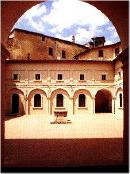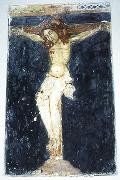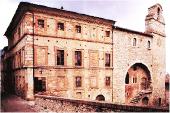San Gemini -
The Old Town Centre of San Gemini
 |
| Chiostro di San Francesco |
The church was originally built in 1200 and is proof that the cult of St Francis flourished in San Gemini at an early stage. St Francis in fact made several trips to San Gemini, even performing an exorcism in 1213. This was allegedly the event that prompted Count Capitoni, whose coat of arms is above the columns of the entrance, to donate some of his lands to the Church so that a Franciscan place of worship could be erected.
Gothic in style, the church of San Francesco has a single nave with seven large arches. A number of fine frescoes within the church have all been recently restored. On the right hand side of the building there is a 15th century depiction of a saint. The first niche contains a St Lucy with St John the Baptist and St Rocco, from the 16th century, while in the the fourth niche there is a depiction of ‘The Doubting of Thomas and St Lucy’, also from the samer period.
 |
| Anonimo: affresco |
Church of Santo Stefano
The former church has been included in the structure of the Violati family house. The apse of the church, still visible today, seems to have been the focal point around which the first houses in the village of San Gemini were built. A number of archaeological finds have been unearthed in the gardens, including two 1st century AD mosaics whose geometric and floral decorative motifs seem to support the theory that a sumptuous villa existed here previously.
Chiesetta Priorale di S.Carlo
This church was previously called Santa Maria de Incertis. Its current name derives from a popular belief that St Charles, Archbishop of Milan, once officiated Mass here. But the church’s previous name also came from an interesting legend, connected with the Esperia bell tower. When the tower’s bell was being cast, a pilgrip from the Holy Land allegedly threw in a silver phial containing seven drops of the Virgin’s milk and spoke the words “in the hour and uncertainty of our death, oh Holy Mary, free us your children”.
Originally the church was made up of a single loggia with an image of the Virgin. It appears that in 1400 it was transformed into the Cappella dei Priori. A number of interesting works of art still survive in its interior. In a small 13th century chapel in the far wall there is a late 15th century ‘Madonna With Angels and St Catherine of Alexandria’. Lower down to the left there is a mounted St George that, transformed into San Gemine, was the original inspiration for the town’s coat of arms.
 |
| Palazzo del Capitano del Popolo |
Known as Palazzo del Popolo or Palazzo Vecchio, this building was the seat of the town’s government. Next to it stands the mighty tower that still contains the "campana delle adunanze" bell, cast in 1318 by the Maestro Matteo d'Orvieto.
Church of St Gemine
Rebuilt many times over the centuries, the Duomo of San Gemini dates back as far as the 12th century. Records indicate that at this time there was a flourishing of the cult of a certain brother Gemine, a monk of Syrian origins who died in 815. The present structure of the church is the result of the 19th century restoration works carried out by the engineer Livoni, who followed some indications provided by Antonio Canova. The restoration works lasted for thirty years, prompted by the discover in 1775 of the saint’s remains in the sacristy. An urn and a plaque are still visible in the sacristy, althought the remains themselves have been moved under the high altar. The church contains some paintings from the 17th century, such as the ‘Martyrdom of St Sebastian’, a ‘Madonna With Child and Holy Bishop’ and a ‘St Matthew Evangelist’.
Abbey of San Nicolò
This building has a very special significance for San Gemini in that St Nicolò, after whom the abbey is named, appears in the earliest document of the city that dates back to 1036. Erected in the 11th century, the abbey has undergone a number of alterations and restoration works through the centuries. The finest part of the construction was the portal, sold to an antique dealer in the 1930s and today housed in the Metropolitan Museum of New York. The doorway that we see today is a copy by the Roman sculptor Fernando Onori, put in place after the restoration works carried out in 1967. The interior is made up of three naves supported by columns and capitals of different provenance. The walls were once decorated with a series of magnificent frescoes, sadly lost. There remain only a ‘Madonna With Child’ by Ruggero da Todi, painted in 1295 and heavily influenced by Duccio and Cimabue, as well as a ‘St Gregory the Great’, probably by the same painter. There is also an allegorical sculpture of a large lion grounding a ram, typical of many Umbrian palazzi.
© Copyright 2001-2025
by Umbriaonline.com
SCG Business Consulting S.a.s. di Giacomelli E. & C. - Internet Advertising Division - © 2001-2025 All Rights Reserved - P.IVA 01675690562